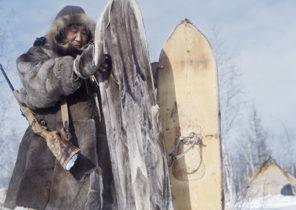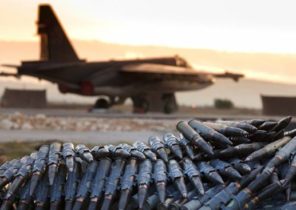
In the Polish army not only bear Wojtek, who was fighting way of the Anders Army (Polish military formation created by the Soviet authorities in the USSR in 1941-42 — approx. TRANS.). The first was a white bear named Murmansk Basica. Her fate takes us back to a forgotten page of the history of Polish armed forces.
Basica was born in the North of Russia and was adopted in the Murmansk part of the Polish squad. In December 1919, she participated in the parade, hosted by the Jozef Pilsudski. Her life, unfortunately, ended tragically.
The history of the unit, which served the fur fighter, began after the Bolshevik revolution of 1917 and Russia’s withdrawal from the First world war, when the poles who served in the tsarist army, were scattered throughout the crumbling Empire. The Creator of the “Blue army” of General Jozef Haller (Józef Haller) decided to use them for the benefit of a resurgent Poland and engage in battles that the forces of the Entente countries were, together with the white against the Reds. In mid-June 1918 Haller was able to obtain the consent of the allies and to begin the recruitment of Polish units on the territory of Russia. Military commissariats appeared in Murmansk and Arkhangelsk. The formation of a battalion of the Polish Riflemen, which included 300 people, was held in the town of Kola. He, along with the British fought with the Bolsheviks and, in particular, took part in the fighting in the area of lake Onega.
Win the heart with the bear
“Early in the spring of 1919, lying on the White sea, Arkhangelsk was occupied by the Entente forces. Under the timid command of English and their contentment they hoped to invade Russia from the North, hang lanterns and red rulers of the Kremlin, but in the first place — to capitalize on the natural resources of this country”, — described the situation at the time Eugeniusz Malczewski (Eugeniusz Małaczewski). He is in the 1920-ies have devoted our heroine book, “History of Murmansk Baski — white bear”.
In 1919, it tells Malczewski, a white Teddy bear bought in the market a Midshipman Karas, who fought with the Italian bersagliere for the location of one lady. They knew that their beloved has a weakness for animals, and appeared in front of her house with all larger fauna. Karas decided to Eclipse the Italian who bought Fox. The duel for the lady ended up being aggressive bear ripped the enemy pole pants and greatly scared him. But, unfortunately, the bear killed him, attacked the dog, which belonged to the British General. After the British complained to the commander of the Murmansk squad Skolkovskomu Julian (Julian Skokowski), he put the Fish under a ten-day arrest, and Basko his order included in the unit as a “daughter of the regiment”, attributing to the gunners.
To tame the animal had corporal Smorgonskoe who had a heavy hand, because he was engaged in training recruits. And, says Malachowski, the bear was “tame as a dog,” and then accompanied the military as a living symbol.
In the autumn of 1919 the poles decided to evacuate to the West. The Biograph Baski claims that the ship with the military and the bear immediately went to Gdansk. Recently, however, the British radio station BBC reported that the ship “Toloa”, released 20 September 1919, from Russia, arrived in Edinburgh. This version is confirmed by the message of the mayor Bronislaw spirit (Bronisław Duch) printed in the brochure, which was published on the occasion of the first Congress “of Murmansk” in 1929. The spirit indicates that the poles landed at a Scottish port on 2 October. The BBC, quoting a local newspaper of the time describes which huge interest was aroused by the appearance on the streets of Polish soldiers in blue uniform, accompanied by white bear.
Basica on parade
1 Dec poles left Scotland on the ship “Helena”, which was supposed to take them to Gdansk, but due to the outbreak on Board the scandal (the details of the incident are unknown) planted them in Szczecin. December 4, immediately after the landfall military went on the train to Poznan. The Polish border they crossed under Krijem-Wielkopolskim and 6 December reached Modlin — new location. The division inspected the General Haller.
In December 1919 Basica together with his unit went on parade, which took on the Saxon square in Warsaw, the head of state Jozef Pilsudski. “Murmansk” was greeted as the true heroes, and the bear inspired the admiration of many onlookers.
“When Pilsudski decided to pet the bear and held out her hand, she immediately gave him her paw,” writes Malachowski. On the remaining photos it looks a little different: it seems that Baska tried to catch future Marshal with his long claws.
Like sister died
Two months later the tragedy occurred. The bear broke loose and swam across the Vistula in the vicinity of the fortress of Modlin. She trusted people, so went to the nearest village. It was noticed by a local resident, Wavion, who at that time were scattered by his sons dung in the field. The farmer killed the bear with a pitchfork, because his wife, Maria needed a coat. When in the village there were soldiers, he was removed from animal skin.
Malczewski describes dialogue as: “Your oversight! Law not know? I risked his life, got down on the ground. I will not give!” — said the farmer. “Severe local people! — exclaimed in despair Smorgonskiy. — Well, guys, for weapons!”
“In response to this call the soldiers, taking with them rifles, instantly dismantled a nearby fence and with the fury of a battalion, throw in a bayonet charge, he wrote on the forehead of Wavion, his sons, friends and neighbors your Murmansk infallible military law, which stands above all other laws. Basico repulsed, they put it on the same Board, which beat the peasants, and, overwhelmed with grief like they died with their sister, suffered to her left at the shore boat”.
From the bear Scarecrow. Tell that for some time it stood in the office of General Haller, when he lived in the house of the owner of the factory, the Torun gingerbread. Then the stuffed animal was transferred to the Polish army Museum, where it survived the Warsaw uprising.
Stella Maria Saharsa (Stella Maria Szacherska) writes in the publication “Colonel Zbigniew Sacharski (Zbigniew Szacherski) — the Director of the Museum of the Polish army in the years of reconstruction of the country”, that “the symbol of the unit, Colonel Stokovskogo, who came with him to Poland (…), until the end of the occupation remained in good condition: it was placed in special glass closet.”
Then through the efforts of the political officers of the Main political Directorate of the Polish army bear, along with other items reminiscent of the glorious days of the struggle with the Bolsheviks, was the Museum’s storerooms. What happened to her next? Unknown. One version States that after the war, the effigy was thrown just because the Communists got rid of everything connected with the history of the Second Polish Republic. According to another version, he was handed over to the Warsaw hunting society. Can be quiet, Basia kept by someone until now?







